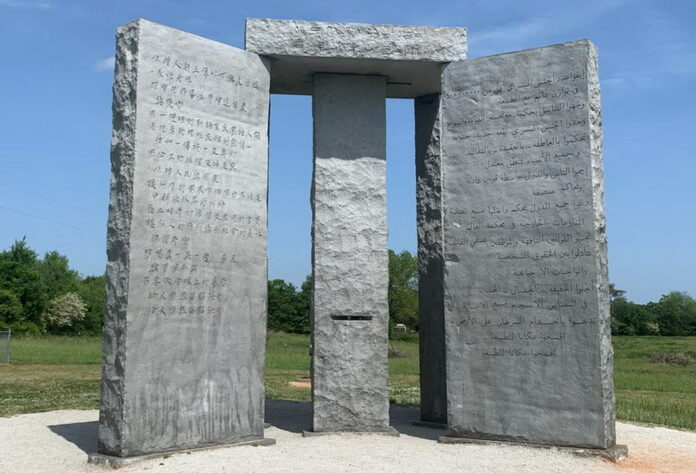The Georgia Guidestones are a large and mysterious monument located in Elbert County, Georgia, USA. Built in 1980, they consist of four huge granite slabs, each weighing around 20 tons, arranged in a circle with a central stone in the middle. On top of these stones lies a capstone. The Guidestones stand 19 feet tall and are made of polished granite, making them an impressive sight.
These stones are often called the “American Stonehenge” due to their mysterious origin and grand design. The true purpose of the Georgia Guidestones remains unknown, adding to their intrigue. The monument attracts many visitors each year who are curious about its origins and the messages it contains.
Inscriptions in Eight Languages
The most striking feature of the Georgia Guidestones is the inscriptions etched into the granite. These inscriptions are written in eight different languages: English, Spanish, Swahili, Hindi, Hebrew, Arabic, Chinese, and Russian. Each side of the four upright stones has a different language, making the messages accessible to a wide range of people.
The inscriptions contain ten guidelines or principles that are meant to serve as advice for humanity. These guidelines cover various topics, including governance, population control, and environmental sustainability. The messages seem to offer instructions on how to rebuild and maintain a healthy and balanced society, especially in the event of a global catastrophe.
The Mystery of the Creator
One of the most intriguing aspects of the Georgia Guidestones is the mystery surrounding their creator. The monument was commissioned by a person using the pseudonym “R.C. Christian.” To this day, no one knows the true identity of R.C. Christian or the group he represented. This anonymity has led to much speculation and numerous conspiracy theories about the stones’ purpose and origins.
R.C. Christian worked with a local granite company to build the monument, providing specific instructions on its design and inscriptions. The secrecy of the project and the anonymity of its backers have fueled rumors and legends, adding to the enigmatic allure of the Guidestones.
Aimed at Future Generations
The guidelines inscribed on the Georgia Guidestones are intended for future generations. They offer advice on how to create a sustainable and peaceful world, emphasizing harmony with nature and careful management of resources. The messages also promote global cooperation and understanding, encouraging people to work together for the common good.
The idea of providing a set of principles for future societies suggests that the creators of the Guidestones were thinking about the long-term survival and prosperity of humanity. Whether these guidelines were meant to be taken seriously or are simply a philosophical exercise remains a topic of debate.
Controversial and Thought-Provoking
The Georgia Guidestones have generated significant controversy and discussion over the years. Some people see them as a positive guide for humanity, offering wise and practical advice for future generations. Others view them with suspicion, interpreting the messages as ominous or authoritarian.
The controversy mainly revolves around the principles of population control and centralized governance, which some interpret as a call for drastic and intrusive measures. Despite the differing opinions, the Guidestones continue to be a source of fascination and debate, prompting people to think deeply about the future of human society.
A Tourist Attraction
Despite the mystery and controversy, the Georgia Guidestones have become a popular tourist attraction. People from all over the world visit the site to see the monument and ponder its messages. The stones are located in a rural area, making them a peaceful and contemplative place to visit.
The local community has embraced the Guidestones, recognizing their value as both a cultural landmark and a tourist destination. Visitors often leave the site with a sense of wonder and curiosity, reflecting on the principles inscribed on the stones and their potential impact on the future.
